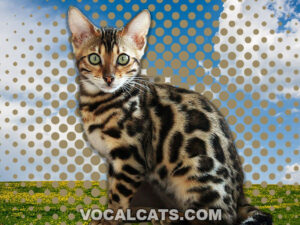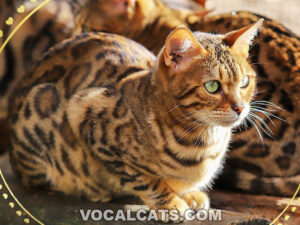When the East meets West, a fusion of two purebred cats, a Siamese that has its origin in Thailand and a Bengal that is developed in the USA. Crossing these two cats produced a stunning Bengal Siamese Mix cat.
Be ready for some adventure because adding a Bengal Siamese cat into your home means lots of playing, climbing, and chasing. But after action-packed activities, this cat will settle down and wants nothing but cuddle moments with his human family.
There are other adorable Bengal cat mixes such as the Bengal Ragdoll Mix. But, for today, it’s all about learning what it’s like to own a Bengal Siamese – from grooming to nutrition, exercise needs, and everything in between. So, let’s get started.
Contents
- Bengal Siamese Mix: Breed overview
- What is a Bengal Siamese Mix?
- Siamese Bengal Mix parent breeds
- How can I tell if my cat is mixed with Siamese?
- Why are Bengal cats so special?
- What 2 breeds make a Bengal cat?
- What are Bengals Mixed with?
- Bengal Siamese Cat genetics
- Siamese vs Bengal
- Is the Siamese Bengal Cat recognized by cat registries?
- Siamese Bengal physical appearance
- How big do Bengal Siamese cats get?
- Bengal and Siamese Mix size, height, and weight
- Bengal Siamese Mix Cat coat colors and types
- Can Bengals be white?
- Snow Bengal Siamese Mix
- How rare is a black Bengal?
- Bengal Siamese Mix personality
- Bengal Siamese cross temperament
- Do Bengal cats attach to one person?
- Do Siamese and Bengal Mix make great family pets?
- Bengal Cat Mixed with Siamese training
- Bengal Siamese Cat Mix exercise requirement
- Siamese Bengal Cat Mix grooming and cleaning
- Does the Bengal Cat Siamese Mix shed a lot?
- Is the Bengal Mix Siamese hypoallergenic?
- Bengal Mixed with Siamese food and diet
- Siamese and Bengal Cat Mix common health issues
- Bengal Siamese Mix lifespan
- Bengal and Siamese breeders
- Bengal Siamese kittens
- Bengal Siamese Mix price
- Places to find Siamese Bengal kittens for sale
- Finding a healthy Bengal Siamese Cat Mix for sale
- Bengal and Siamese Cat: Pros and Cons
- Is the Bengal and Siamese Mix Cat right for me?
- Related Questions
Bengal Siamese Mix: Breed overview
| Size | Medium |
| Weight | 10 – 15 pounds |
| Height | 8 – 10 inches |
| Coat Colors | Black, Brown, Tan, White |
| Child Friendliness | Moderate |
| Feline Friendliness | Moderate |
| Training Difficulty | Moderate |
| Grooming Upkeep | Moderate |
| Exercise Needs | Moderate – High |
| Health | Moderate |
| Lifespan | 12 – 16 years |
| Kitten Cost | $250 – $1,000 |
What is a Bengal Siamese Mix?
The Bengal Siamese Mix is a half Bengal half Siamese Cat. This domesticated mixed breed has an athletic physique and a spotted coat that makes him seem exotic and wild-looking.
RECOMMENDED: Siamese Ragdoll Cat (Ragamese Complete Guide)
Siamese Bengal Mix parent breeds
Since the Siamese Bengal Mix is a cross between 2 different cat breeds, it is useful to look into each of the individual parent’s characteristics. This is to give us a clue on how the Bengal Siamese would turn out.
The Bengal Cat is unique in its appearance because of its coat pattern. It resembles that of the leopard with its distinct shapes of rosettes, spots, and stripes that have a dark outline and lighter-colored center.
Despite their wild look, Bengal Cats are affectionate with a very playful and active personality.
The Siamese Cat, in contrast, has a color pointed coat with a pale body coat and darker points on its extremities, such as the face, ears, legs, and tail.
Similar to the Bengal Cat, the Siamese is quite active with a vocal and sociable personality. It would not be unusual to hear them meowing or yowling loudly to express their feelings and get your attention.
Siamese Cat origin
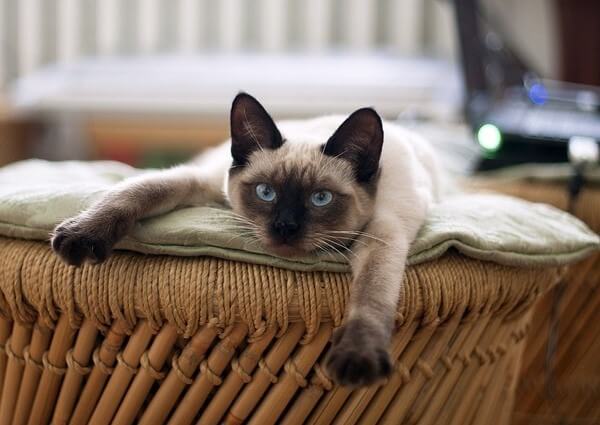
The earliest known depiction of Siamese Cats is found in the Tamra Maew or The Cat-Book Poems. It was written during the time of the Ayutthaya Kingdom in Siam, now present-day Thailand, between the 14th and 18th centuries.
The breed was introduced in the West during the 19th century and through several generations of selective breeding, resulted in a breed with a more elongated and tubular physique compared to the original.
CHECK OUT: Russian Blue Mixed with Siamese (Complete Guide)
How can I tell if my cat is mixed with Siamese?
3 physical characteristics can give you a clue if you suspect your cat is part Siamese.
- Eye color – All Siamese Cats have a striking blue eye color that ranges from light to dark blue.
- Coat – Siamese Cats have a distinctive color pointed coat with dark-colored extremities at the mask, ears, legs, and tail.
- Head shape – Modern Siamese Cats have a wedge-shaped triangular head with large ears that stick out.
Bengal Cat origin
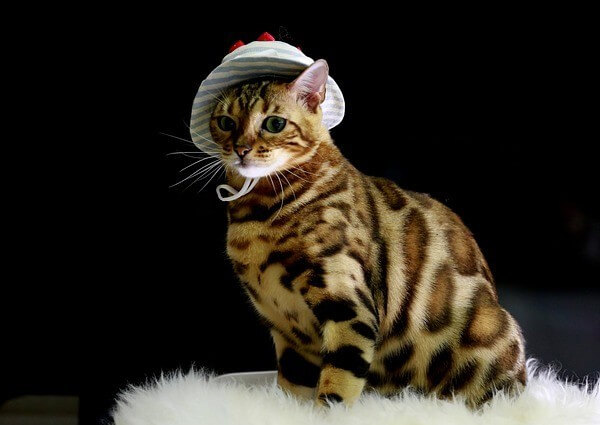
The Bengal Cat was originated by Jean Mill in 1963 in California by crossing an Asian Leopard Cat with a Domestic Shorthair.
Over the years, after her initial attempt, the breeding program suffered some difficulty until she obtained some Bengal cats being bred in a genetic testing laboratory.
By the early 1980s, the breed was fully developed and by 1983 was recognized by The International Cat Association as an official breed.
Why are Bengal cats so special?
Bengal cats are special because they are the only domesticated cat breed that sports the rosette markings that is the hallmark of the wild Asian Leopard. The rosettes have a dark outline and sharp edges with the center being lighter in color.
The coat of the Bengal cat also differs from most domesticated cats. They have a very short and soft pelt that is different from the fur of most cats.
What 2 breeds make a Bengal cat?
The Bengal cat is a cross between the small wild Asian Leopard Cat (Prionailurus bengalensis) that is a native of the southeast and northeast Asia and a domestic short-haired cat like the Egyptian Mau, Abyssinian, or Burmese.
What are Bengals Mixed with?
Bengals are typically mixed with domestic short-haired cats of no particular breed such as a shorthair tabby cat, Oriental Shorthair, Abyssinian, and Egyptian Mau cats. Recently, there is an ongoing trend to mix them with long-haired cats like the Maine Coon and the Ragdoll.
Bengal cats that were bred from an Asian Leopard Cat and a domesticated shorthair are called F1 Bengals. These 1st generation Bengals are still considered “wild” and might not be suitable as indoor cats.
This is also true for 2nd and 3rd generation Bengal Cats, or F2 and F3 respectively, which still exhibit signs of being wild.
The generation of Bengal cats starting from F4 onwards are considered truly domesticated.
READ ALSO: Tabby Bengal Cat (Complete Guide)
Bengal Siamese Cat genetics
Various genes affect the coat pattern of the Bengal Siamese cross. The Siamese cat carries the Himalayan gene that causes partial albinism in the warmer parts of the body.
This is the reason why the colder parts, such as the face, ears, legs, and tail are darker than the rest of the body.
The spotted or marbled pattern in Bengals is controlled by the “Sp” gene. A dominant “Sp” would produce a rosette tabby pattern while a recessive “sp” would produce a marbled tabby pattern.
Siamese vs Bengal
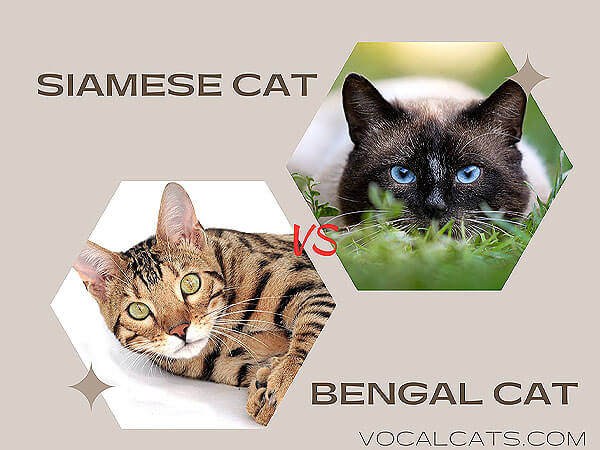
The main difference between Siamese and Bengal is that Siamese has a colorpoint coat while Bengal has a rosette or marbled coat.
READ NEXT: Maine Coon Siamese Mix (Complete Guide)
Is the Siamese Bengal Cat recognized by cat registries?
Unfortunately, the Bengal x Siamese Cat is not recognized by cat registries such as the Cat Fanciers’ Association (CFA) or The International Cat Association (TICA).
This is because they are not purebred cats that have a standard set of physical characteristics.
Siamese Bengal physical appearance
Bengal x Siamese Cat has slender, muscular physique with a tapered head shape that can be smaller in proportion to their body. The rear legs are slightly longer than the front which makes them good jumpers.
How big do Bengal Siamese cats get?
Bengal Siamese cats are generally medium in size. The length of their body depends on whose genes are more dominant. Bengal cats have lengthier bodies ranging from 10 to 16 inches while Siamese cats are only 8 to 11 inches long.
Bengal and Siamese Mix size, height, and weight
Siamese and Bengal Cat Mix has a height range of 8 to 10 inches with the males being more muscular and heavier. Below is a chart showing an estimate of how big they will be upon maturity.
| Gender | Height | Weight |
| Male | 9 – 10 inches | 12 – 15 pounds |
| Female | 8 – 9 inches | 10 – 12 pounds |
Bengal Siamese Mix Cat coat colors and types
Bengal cross Siamese Cat almost resembles the rosette or marbled coat pattern of its Bengal parent. Colors range from black, brown, tan, blue, seal, silver, and white.
Lynx point Siamese Bengal Mix
The pattern exhibited on this coat type consists of tabby markings on the forehead, legs, and tail. The body coat would also have random rosette markings with distinct sharp outlines with a lighter center.
DON’T MISS: Bengal Tabby Mix (Complete Guide)
Can Bengals be white?
Bengals cannot be completely white. They may have a creamy white background color with light to dark seal markings such as the Snow Lynx Bengal.
Snow Bengal Siamese Mix
Siamese snow Bengal or a white Siamese Bengal Mix exhibits a white creamy base color with rosette or marbled seal markings. Snow Bengal Siamese would always have blue eyes.
You may be interested in: Snowshoe Siamese Cat (Complete Guide)
How rare is a black Bengal?
The Black Bengal is quite rare because the recessive non-agouti gene that causes excessive black pigmentation is uncommon in Bengal cats. Both parents must carry the gene for an offspring to be black.
Black Bengal cats have a black base color with black spots and no warm tones. The rosette markings can be visible only in natural sunlight.
Bengal Siamese Mix personality
The half Siamese half Bengal Mix can be expected to be playful and active due to their wild ancestry. They are outgoing and very curious to explore their environment.
Given that Bengal cats are powerful climbers, it is recommended that you provide them with a high perch, such as a cat tree, where they could climb and rest.
Bengal Siamese cross temperament
The Bengal Mix Cat is an affectionate and friendly breed that loves the company of its humans. They can be hard to handle sometimes and get into mischievous behavior if left alone for too long.
You might also notice that they are vocal and wouldn’t hesitate to express their emotions through loud meowing and yowling.
Do Bengal cats attach to one person?
The Mix Bengal Cat does tend to have a favorite person in the family, especially one who gives it more attention, and of course, treats. Being in the company of this person gives them a sense of security and comfort.
Do Siamese and Bengal Mix make great family pets?
Yes, this Bengal Cat Mix is a fun addition to active families. They may not be suitable for some families because of their hyper energy, but they get along well with most children.
They are also fine with other cat-friendly pets as long as Siamese Bengal Mix kittens are socialized early on to get them used to each other.
Bengal Cat Mixed with Siamese training
The Siamese Bengal Mix is fairly easy to train since they are active and inquisitive. Bengal x Siamese kittens can be trained to use the litter box as early as 3 weeks old.
They can also be taught to follow basic rules around your house. The important thing is to employ positive reinforcement techniques, like rewarding them with cat treats and petting, to keep them motivated to follow you.
Bengal Siamese Cat Mix exercise requirement
Bengal Siamese Cat Mix needs around 10 to 15 minutes of physical activity 2 to 3 times a day. They are very active, especially Siamese and Bengal kittens, so they should be provided with enough physical and mental stimulation.
Like most kittens, a Bengal Mix kitten would be most active during the early mornings and evenings. It is ideal to provide them with places where they can hide and climb, such as cat trees or towers.
Siamese Bengal Cat Mix grooming and cleaning
Siamese x Bengal kittens may sport a short coat but grooming should still be a part of their regular care such as the following:
Brushing
Basically, you need more than one grooming tool to keep the coat of a Mixed Bengal cat shiny and mat-free. A de-shedding tool is best to target the inner coat and minimize shedding. Plus, a wide-tooth comb comes in handy for de-tangling heavily-formed mats.
Bathing
Occasional baths will keep the coat of a Siamese Bengal mix clean and shiny. Use a gentle shampoo made with mild and organic ingredients so as not to dry the skin and coat.
In between baths, you can wipe his coat with pet wipes. Dry shampoo for cats is also a great alternative to clean and condition the skin and coat.
Teeth Brushing
Keep those teeth shiny and pearly white by regularly cleaning the insides of his mouth. Best to use a finger toothbrush to reach the corners of his mouth. For toothpaste, an enzymatic toothpaste for cats is the right choice.
Nail Trimming
Trimming his nails with a small cat clipper prevents your kitty from scratching your skin and damaging your furniture. After trimming, smoothen the edges of his nails with a nail grinder.
Ear/Eye Cleaning
Simply cleaning the eyes and ears with a moistened cotton will keep infections at bay.
| Grooming Needs | Grooming Frequency |
| Brushing | 2x/week |
| Bathing | Once a month or fewer |
| Teeth Brushing | 3x/week |
| Nail Trimming | 2x/month |
| Eye/Ear Care | Check weekly |
Does the Bengal Cat Siamese Mix shed a lot?
Yes, mixed Bengal kittens shed their coats but not as heavily compared to other cat breeds.
Aside from grooming, you can manage your cat’s shedding in your home by cleaning it with a vacuum cleaner with a HEPA filter. This cleaning tool can capture more than 95% of tiny particles that include cat fur and dander.
Is the Bengal Mix Siamese hypoallergenic?
No, Bengal Mixed kittens are not hypoallergenic. All cats produce Fel d1 protein in their saliva, urine, and skin.
When a Bengal Mix Siamese licks its coat to clean, his saliva dries up and becomes an airborne allergen. No need to worry because an air purifier with HEPA filter works well by capturing even the minuscule airborne allergen in your home.
Bengal Mixed with Siamese food and diet
Bengal cross Siamese kittens need a lot of animal-based protein in their diet. As obligate carnivores, the Bengal Cat Mix breed only requires a very low amount of carbohydrates in their diet.
Regardless of age, taurine is an important amino acid for cats, which, unfortunately, they do not produce. Lack of taurine leads to vision and heart problems. So, always choose high-quality cat food that contains taurine.
Siamese and Bengal Cat Mix common health issues
Siamese cross Bengal kittens can inherit the gene-specific health issues of their parents. And, this is where the importance of genetic testing such as DNA home test kits comes in.
Responsible breeders perform DNA tests on all their cats before using them for breeding. This is done to prevent passing on to the Siamese cross Bengal kittens the diseases such as these 5:
1. Polycystic Kidney Disease (PKD)
Affected kittens are born with small cysts that continue to enlarge and multiply in their kidneys. In time, PKD can cause renal failure.
2. Hypertrophic Cardiomyopathy (HCM)
This is an inheritable cardiac disease in cats that causes the muscular walls of the left ventricle to enlarge. This results in oxygen starvation and abnormal heartbeats.
3. Feline Lower Urinary Tract Disease (FLUTD)
This refers to the various infections in the urethra and bladder. Pain and vocalizing while urinating are the signs to look for.
4. Lymphoma
More commonly seen among Siamese cats, lymphoma is a cancer that affects the production of white blood cells.
5. Amyloidosis
An inherited disease that is commonly seen among Siamese cats due to the breed’s different makeup of serum amyloid A. This disease can affect the different organs but the kidneys are always affected.
Bengal Siamese Mix lifespan
The average life expectancy of a Mixed breed Bengal Cat is 12 to 16 years.
Bengal and Siamese breeders
The best option for finding Bengal Mix kittens is from reputable breeders. These individuals are dedicated to raising and producing healthy Bengal Mixed breed kittens.
Reputable breeders are members of cat associations such as TICA and CFA. As members, breeders are expected to respect and fulfill all the guiding principles in cat breeding practices such as DNA testing.
Bengal Siamese kittens
The right age to adopt a Siamese Bengal kitten is 12 weeks. Kittens need a longer time with their moms and littermates to learn ‘good values’ and feline etiquette.
What should you look for in Bengal Siamese kittens? Choose a kitty that is playful yet not overly aggressive. Do not choose a kitty that hides in the corner or a kitty that bullies its littermates.
Instead, look for a Siamese Bengal kitten that is not afraid of meeting new faces, does not hiss when petted, and is physically active.
Bengal Siamese Mix price
Bengal Siamese Cat price is from $250 to $1,000. The price of the kittens is based on factors like coat color, pedigree, and breeder’s reputation.
After thinking of the price of the kitty, the next thing to think about is Bengal Siamese Mix cost maintenance like monthly food expenses. Here’s a table to give you an idea of what and how much you should spend on your fur baby.
| Type of One-Time and Recurring Expenses | Average Cost |
| Food | $30 – $50/month |
| Food and Water Bowls | $5 – $10 |
| Kitty Bed | $20 – $30 |
| Carrier | $20 – $40 |
| Collar and ID tag | $10 – $25 |
| Grooming Tools | $25 – $45 |
| Litter Box | $18 – $45 |
| Litter | $15 – $25/month |
| Scratch Post and other toys | $20 – $50 |
| Microchipping | $50 – $100 |
| Spaying | $250 -$550 |
| Veterinary Expenses | $200 – $500 |
| Total | $663 – 1,470 |
Places to find Siamese Bengal kittens for sale
If you’ve already decided to get a Siamese Bengal kitten, we want to share with you a list of reputable breeders who are members of TICA. These breeders may currently have Bengal Siamese Mix kittens for sale. Otherwise, you can sign up for their waitlist.
Siamese Bengal Mix kittens for sale Florida
If you are a resident of Florida and still searching for Bengal Siamese kittens for sale near me, why don’t you give Bell Arista Bengals (bellaristabengals.com) a try? All cats and kittens are raised in their homes and are well-socialized. They are up-to-date on all vaccines, deworming, and anti-flea schedules.
Bengal Siamese cross kittens for sale Maryland
Royal Bengal Cattery (royalbengalcattery.com) is a place to search for kittens that are free from genetic diseases. All breeding cats and kittens also tested negative for FIV and FeLV.
Siamese x Bengal kittens for sale UK
The breeder/owner of Pollybee Siamese & Orientals (pollybeesiamese.co.uk/) is a member of the Governing Council of the Cat Fancy in the UK. For inquiries, kindly send a text, email, or call the breeder in the contact information found on her website.
Finding a healthy Bengal Siamese Cat Mix for sale
Are you interested in looking for Siamese Bengal for sale? Unlike kittens, adult cats have already developed good manners, so less, training and disciplining on your part. For this section, we will provide you with 2 links where to possibly find a Bengal Siamese Mix for sale.
Skagitbengals.com located in Mount Vernon, Washington could be a place to find a Siamese Bengal Mix for sale.
If you’re a resident of North Carolina and still haven’t found an adult Bengal Siamese Cat for sale, do check out the webpage of Capstone Bengals (capstonebengals.com). If you’re in luck, the breeder may have an available Siamese Bengal Cat for sale.
In case both breeders cannot help you find an adult Bengal Siamese Mix Cat for sale, the next option to search for Bengal Siamese Mix Cats for sale are rescue centers near you.
Bengal and Siamese Cat: Pros and Cons
Before deciding to get a Bengal Cat Mixed with Siamese, it is useful to learn about the pros and cons of owning such a breed.
| Pros | Cons |
| Affectionate | Can be hyper |
| Smart | Tendency to have separation anxiety |
| Unique-looking coat | Can be loud |
| Great for active families | Tendency to be mischievous |
| Easy to groom | Territorial |
| Even-tempered | Loves to scratch |
Is the Bengal and Siamese Mix Cat right for me?
If you give them enough attention, Bengal Cat Mixes can be the right breed for you. Remember that this mix has a wild ancestry. This makes them hard to handle sometimes because of their tendency to be more feral than domesticated. They may become destructive if not given proper physical and mental stimulation.
Related Questions
The Sokoke cat from Kenya is one of the rarest cat breeds in the world. It is estimated that there are only around a hundred of this breed that exist.
The best Bengal cats are ones that belong to the F4 and above generations. Early-generation Bengal cats tend to be more feral and can be hard to domesticate.
The most popular Bengal cat color is brown with jet-black rosette markings and a black-tipped tail.
Bengal Mix Cats can live between 12 to 16 years or more provided they are given proper care and nutrition.
One of the cons of owning a Bengal cat is that they need more physical activity and mental stimulation than most average cats. They can resort to mischievousness if they get bored or are not given enough attention.
DISCLAIMER: THIS WEBSITE DOES NOT PROVIDE MEDICAL ADVICE
The information, including but not limited to, text, graphics, images and other material contained on this website are for informational purposes only. No material on this site is intended to be a substitute for professional veterinary advice, diagnosis, or treatment. Always seek the advice of your veterinarian or other qualified health care provider with any questions you may have regarding a medical condition.
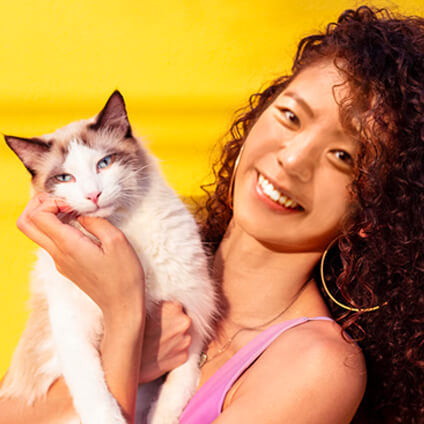
With over five years of specialized experience as an animal writer, my expertise lies in cat nutrition, health, behavior, grooming, and training. I am dedicated to delivering helpful and informative content that caters to the well-being of our feline friends. My primary goal is to empower pet owners with knowledge and ensure our feline companions thrive in health and happiness. In my free time, I love volunteering at local cat rescue centers.





